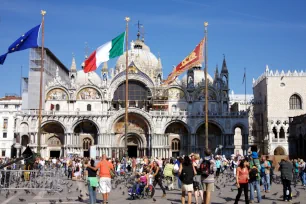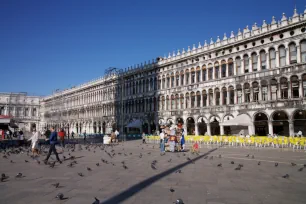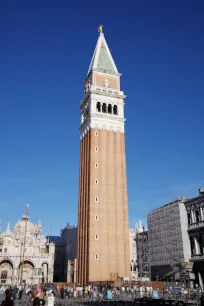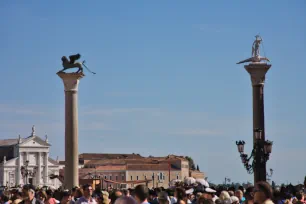Venice’s principal square is full of history and surrounded by great architecture. Several of Venice’s major sights are located here, so the square is often crowded with tourists.
Early History

Piazza San Marco was constructed in the ninth century as a small square dotted with trees. The square was laid out in front of the original St. Mark’s Basilica, at the time a small chapel which was part of the Doge’s Palace.
The square was separated from the palace by a small canal, the Rio Batario. Already a central gathering place for Venetians, the piazza was enlarged in 1174 after the canal and an adjoining dock were filled in. The square became paved with bricks in 1267 in a herringbone pattern. In 1735 the bricks were replaced with natural stone and laid in a more complicated pattern according to a design devised by architect Andrea Tirali. The design marked the location where merchants could set up their stalls.
Around the Square

As the largest square in the city and the only one given the designation of “piazza” (the others are all referred to as “campi”), St. Mark’s Square has always been the location of important government buildings and other facilities central to the goings on in Venice.
The centerpiece of the piazza is, of course, magnificent St. Mark’s Basilica. Commissioned in 1071 by doge Domenico Contarini, this amazing church is built in Venetian-Byzantine style, a mixture of western and eastern styles.

Nicknamed the “Church of Gold” because of its opulence, it has been the seat of the Patriarch of Venice, archbishop of the Roman Catholic Archdiocese of Venice, since 1807.
The basilica has a separate campanile – bell tower – that stands 98.6 meters tall (323 ft) and is one of the city’s most recognizable landmarks. Originally built in the ninth century, the current version was rebuilt in 1912 after the original tower collapsed in 1902.
The other dominant building around St. Mark’s Square is the Doge’s Palace. A beautiful Gothic structure, it faces the Venetian lagoon and was completed in the early fifteenth century, though portions of it were rebuilt after a fire in 1574.

Also located along the square are the twelfth century Procuratie Vecchie, buildings that housed the apartments and offices of the procurators; the Procuratie Nuovo, which provided more offices and was built in the mid-seventeenth century; the National Library of St. Mark’s; the Museum of Archaeology; and the Correr Museum.
Between the Palace of the Doge and the Library is the Piazzetta (little piazza) San Marco. It is known for the two columns located there that pay homage to two of Venice’s patrons – St. Mark and St. Teodoro of Amasea. The columns have long served as the official gateway to the city. Until the mid eighteenth century, the piazetta was also an area were criminals were executed.
Venetian Pigeons

Besides being filled with people and great specimens of architecture, Piazza San Marco is also full of pigeons. Pigeons have long been a problem in the square but only recently did the city pass a law that banned the feeding of these birds.
The pigeons have caused much damage to the delicate mosaics on St. Mark’s Basilica and to other buildings around the piazza. Several attempts have been made to control the pigeon population but few have been even slightly successful.

